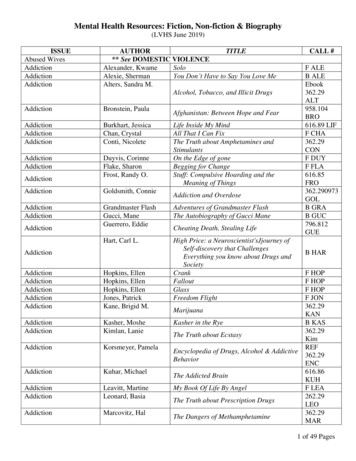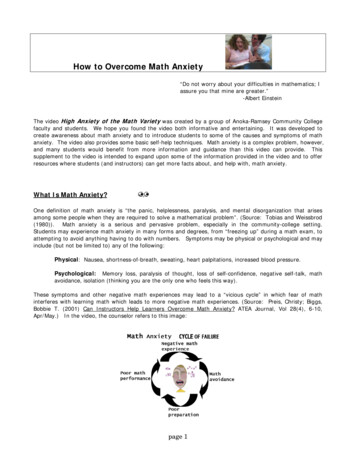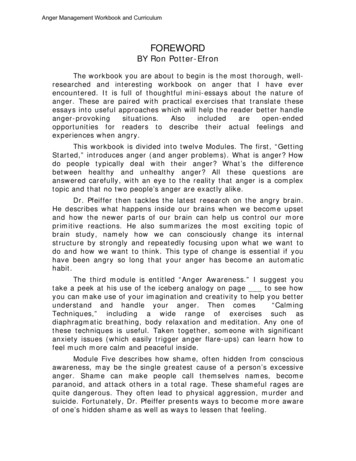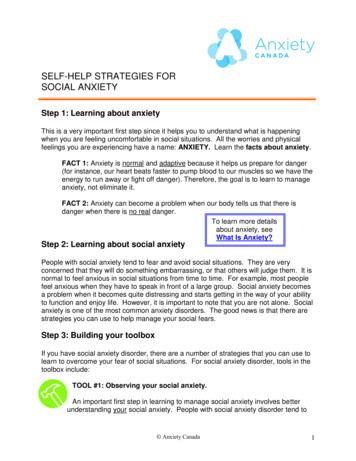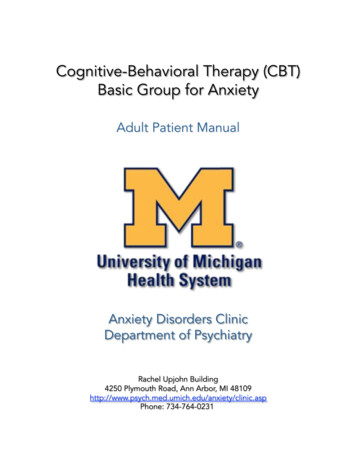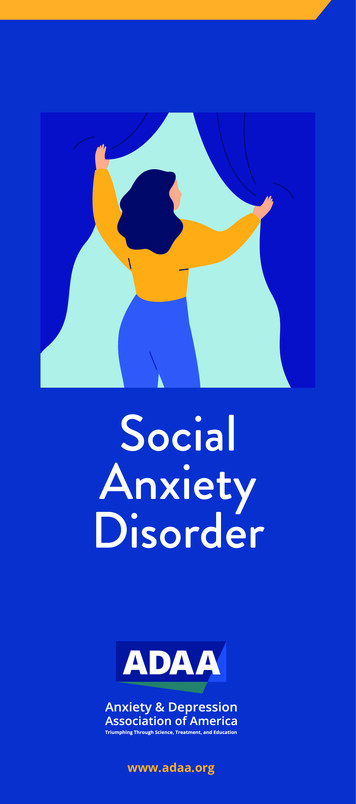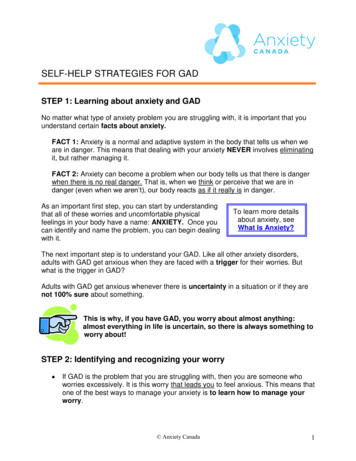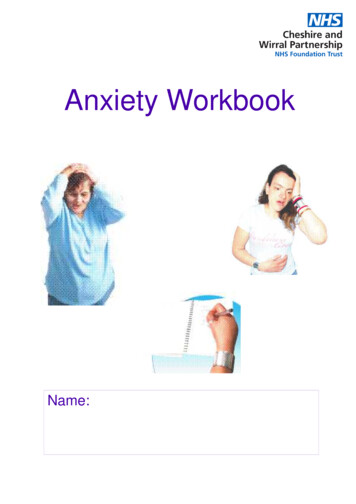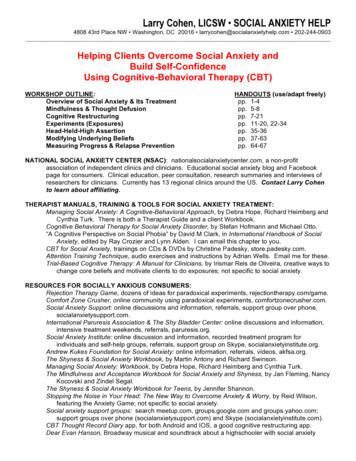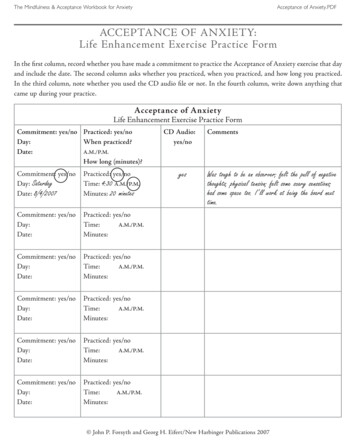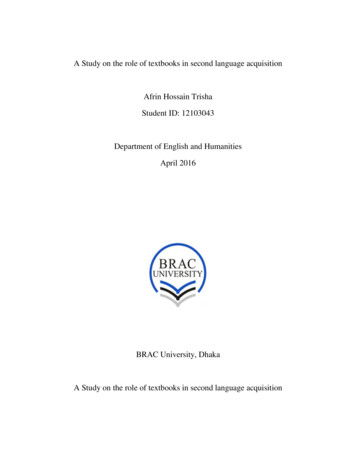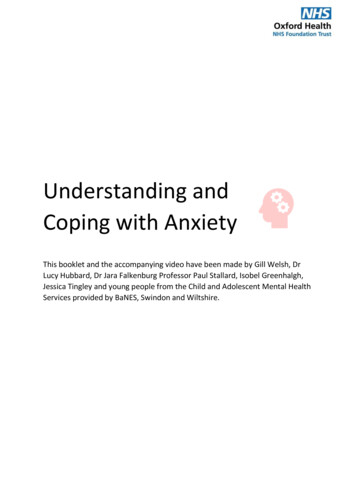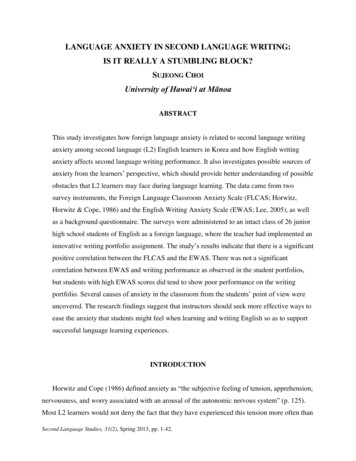
Transcription
LANGUAGE ANXIETY IN SECOND LANGUAGE WRITING:IS IT REALLY A STUMBLING BLOCK?SUJEONG CHOIUniversity of Hawai‘i at MānoaABSTRACTThis study investigates how foreign language anxiety is related to second language writinganxiety among second language (L2) English learners in Korea and how English writinganxiety affects second language writing performance. It also investigates possible sources ofanxiety from the learners’ perspective, which should provide better understanding of possibleobstacles that L2 learners may face during language learning. The data came from twosurvey instruments, the Foreign Language Classroom Anxiety Scale (FLCAS; Horwitz,Horwitz & Cope, 1986) and the English Writing Anxiety Scale (EWAS; Lee, 2005), as wellas a background questionnaire. The surveys were administered to an intact class of 26 juniorhigh school students of English as a foreign language, where the teacher had implemented aninnovative writing portfolio assignment. The study’s results indicate that there is a significantpositive correlation between the FLCAS and the EWAS. There was not a significantcorrelation between EWAS and writing performance as observed in the student portfolios,but students with high EWAS scores did tend to show poor performance on the writingportfolio. Several causes of anxiety in the classroom from the students’ point of view wereuncovered. The research findings suggest that instructors should seek more effective ways toease the anxiety that students might feel when learning and writing English so as to supportsuccessful language learning experiences.INTRODUCTIONHorwitz and Cope (1986) defined anxiety as “the subjective feeling of tension, apprehension,nervousness, and worry associated with an arousal of the autonomic nervous system” (p. 125).Most L2 learners would not deny the fact that they have experienced this tension more often thanSecond Language Studies, 31(2), Spring 2013, pp. 1-42.
CHOI - LANGUAGE ANXIETY IN SECOND LANGUAGE WRITING2not while learning an L2. Many might feel embarrassed without knowing what to do about thissubjective feeling of anxiety. Do we really have to address this vague feeling—anxiety in secondlanguage acquisition? Gardner (1980) argued that affective variables play an integral role insecond language acquisition and we cannot have a thorough understanding of second languagelearning if we ignore these social-psychological factors. Out of many affective variables, anxietyis one that it may indeed be possible to quantify, and developing hypothesis-driven research onthe impacts of anxiety on language learning may facilitate the process of guiding L2 learnerstowards a more pleasant learning experience in the long run.Although there has been some research on the correlation between anxiety and languageacquisition, most of it has been conducted in an ESL context with college-level students.Therefore, a goal of this study is to expand research on anxiety in language learning byconducting research in an EFL context with junior high school students. More specifically, theresearch was designed to find out whether general language learning anxiety is related to anxietyin second language writing, and to uncover possible sources of anxiety related to English writingperformance. By focusing on the role of anxiety in writing performance among L2 Englishlearners in Korea, I hope to provide some genuine understanding of anxiety and how it can beaddressed in order to support successful second language acquisition in EFL high school andjunior high school contexts.Review of the LiteratureAnxiety researchers commonly divide anxiety into three categories: trait anxiety, stateanxiety, and situation specific anxiety. Trait anxiety refers to “a stable predisposition to becomeanxious in a wide range of situations” (Spielberger, 1983, cited in MacIntyre, 1995, p. 93). Stateanxiety refers to “an immediate, transitory and emotional experience with immediate cognitiveeffects” (Spielberger, 1983, cited in MacIntyre, 1995, p. 93). The term “situation specificanxiety” was coined by MacIntyre and Gardner (as cited in Horwitz, 2001, p. 113) and refers tothe continuous and varied nature of some anxieties. According to Gardner (1979) and Horwitz etal. (1986), foreign language anxiety should be understood as situation specific anxiety, whichcan give researchers or instructors an opportunity to see how anxiety triggered by specificlearning environments affects language learning itself. Horwitz et al. (1986) expected learners toshow three major performance anxieties (communication apprehension, test anxiety, and fear of
CHOI - LANGUAGE ANXIETY IN SECOND LANGUAGE WRITING3negative evaluation) in general foreign language learning classrooms, and they concluded thatanxiety could take place in any setting intertwined with language performance.Researchers soon realized that they needed to measure anxiety itself by using objective toolsif they wanted to see whether a high level of anxiety hinders language learning or not. With theincreasing demand for tools to measure anxiety, Horwitz et al. (1986) developed the ForeignLanguage Classroom Anxiety Scale (FLCAS). Many researchers have since used or adapted theFLCAS to measure foreign language classroom anxiety among learners and tried to correlateanxiety to students’ language performance.Most of the research done on anxiety, however, has focused on finding correlations betweenanxiety and oral performance (Hewitt & Stephenson, 2011; Horwitz, 2001; Liu, 2007; Phillip,1992; Young, 1986; Zhang, 2004). That is because many researchers believe that speaking is themost anxiety-provoking of the four language skills. It requires risk-taking from students and asksfor students to reveal their possibly insufficient linguistic knowledge in front of the whole class(Daly, 1991; MacIntyre & Gardner, 1991). Moreover, when anxiety began to be investigatedduring the 1980s, it was a time filled with interest and enthusiasm for communicative languageteaching, which of course emphasized orally oriented classroom activities. Therefore, it seemednatural that many researchers showered interest on speaking. Recently, however, moreresearchers have started to look into the relationship between anxiety and the other languageskills as well: reading (Brantmeier, 2005; Saito, Garza, & Horwitz, 1999), listening (Elkhafaifi,2005; Vogely, 1998), and writing (Cheng, 2004).The majority of findings have implied that anxiety plays a detrimental role in languageacquisition. MacIntyre and Gardner (1989) found that there was a significant negative correlationbetween anxiety and performance on a vocabulary learning task among 104 psychology students,and Aida (1994) also found a significant negative correlation between foreign languageclassroom anxiety and final grades among Americans majoring in Japanese, in terms of speechand negative evaluation. Moreover, Elkhafaifi (2005) did an empirical study of the effect offoreign language learning anxiety on students’ achievement in Arabic and showed low listeningcomprehension scores among anxious students.According to Cheng (2002), there have been only a few studies that directly deal with L2writing anxiety. Those that exist have been done with ESL students from heterogeneous firstlanguage backgrounds. Thus, there is even less research on anxiety among linguisticallyhomogenous second language groups studying in EFL contexts. This means we should turn the
CHOI - LANGUAGE ANXIETY IN SECOND LANGUAGE WRITING4research spotlight on L2 writing anxiety and on EFL contexts. Cheng, Horwitz, and Schallert(1999) stated that writing anxiety is a “language-skill specific anxiety,” which is different from ageneral classroom type of anxiety (p. 417). Also, according to Daly (1978), writing apprehensionis a “situation and subject-specific individual difference” (p. 10), and highly apprehensive writershave a tendency to avoid the very activities they need to be successful writers: writing, practicingwriting, and getting feedback on writing. As a result, many apprehensive learners end upshowing quite poor performances in writing. Faigley, Daly, and Witte (1981) also mentioned thathighly anxious writers produced shorter and less fluent writing than writers with low anxiety.Although some researchers agree that there is a significant negative correlation betweenlanguage anxiety and writing performance (e.g., Cheng et al., 1999; Daly, 1978; Faigley et al.,1981), there are other researchers who argue that the focus should be not on anxiety per se but onstudents’ beliefs about their own capability or competence, which is what brings about differentoutcomes in students’ actual writing performance (e.g., Pajares & Johnson, 1994). In other words,these researchers say that anxiety itself is not an independent variable but a “commonmechanism”(p. 164), which is heavily influenced by the confidence or self-efficacy that studentsmight have when performing tasks, and eventually influences academic outcome. While theyacknowledge that there is a correlation between anxiety and students’ writing, they think writinganxiety does not directly influence students’ writing performance. The present study will notaddress this matter, because there have been few empirical investigations to explore the influenceof the role of students’ perceptions on their own competence. This could be a new research areain the future.Purpose of the StudyThis study addresses the issue of how foreign language classroom anxiety and Englishwriting anxiety are related among junior high school L2 English learners in Korea. The majorgoal is to see whether students who demonstrate general language anxiety in the classroom willalso be anxious about L2 writing and vice versa. The secondary aim is to explore how Englishwriting anxiety affects learners’ actual writing performance during their EFL course. Althoughthere are not many writing tasks done in traditional Korean English classrooms, the learnerstargeted in this study had free writing in English on a biweekly basis. They wrote freely aboutvarious topics such as family, hobbies, favorite movies, songs etc. assigned by the instructorduring a 45-minute class. They eventually compiled this free writing into a performance-based
CHOI - LANGUAGE ANXIETY IN SECOND LANGUAGE WRITING5portfolio assignment that their teacher formally graded. Thus, they seemed to have enoughexperience to participate in the survey and share their personal experience related to L2 writing.Finally, the third aim of this study is to find out learners’ own explanations about their L2writing anxiety and to see what made these Korean L2 learners feel frustrated or less motivatedin their L2 writing in this junior high school class. This study addresses three research questions:1. Is English writing anxiety related to general foreign language classroom anxiety?2. How does English writing anxiety affect English writing performance on the performancebased portfolio assignment implemented in this course?3. What do the students identify as the sources of their English writing anxiety?HypothesesResearch question 1. The first hypothesis is that there is a high correlation between foreignlanguage classroom anxiety and English writing anxiety. Students who say they suffer from highanxiety in general in this EFL classroom are expected to also suffer from high anxiety about L2writing.Research question 2. Performance-based tests in Korea serve as a complementary testmeasurement of students’ class grades, especially for writing and speaking skills in English,which are assumed to be hard to measure through traditional paper and pencil tests. The groupparticipating in the research had done free writing activities throughout the semester, leading to awriting portfolio assignment. Students did free writing on various topics on a biweekly basis.They submitted the writings, which would be grouped as a portfolio at the end of the semester,and then the teacher graded them according to the rubric she had introduced at the beginning ofthe semester. Therefore, the grades for the writing portfolio assignment can be considered anindirect measure of how well or poorly students performed in their actual writing, and then thegrades can be compared to the individual responses about English writing anxiety. Students withless English writing anxiety are expected to have better grades on their writing portfolios thanstudents with more English writing anxiety, because highly anxious students are not expected toproduce lengthy or fluent written pieces, due to their lack of confidence or their tendency toavoid writing.Research question 3. Although the participating students had not had much experience withEnglish writing in the classroom other than their free writing in this course, they were expectedto be able to talk about what they perceive to be possible sources of their nervousness, based on
CHOI - LANGUAGE ANXIETY IN SECOND LANGUAGE WRITING6their experience with free writing for their portfolio assignment. The hypothesis is that anxiousstudents will attribute their anxiety to the difficulties they face because of their limitedproficiency in English. The researcher expected that anxious students would face difficultiesattributed to their limited proficiency in English.METHODOLOGYParticipantsA total of 26 ninth graders (13 females and 13 males), who were enrolled in an advancedEnglish track in their junior high school in Korea, and their EFL teacher participated in the study,as did their EFL teacher. The age of the students ranged from 14 to 15 years old; the average agewas 14.7 years old. None of them had any experience going abroad to take intensive Englishcourses. One of the students had visited an English-speaking country for two months, but did nottake any intensive course or classes while abroad. The majority (20 out of 26 students) reportedthat they had taken an English writing class outside of school. Each student’s total years ofstudying English ranged from 4 to 10 years, with an average of 7.2 years. As ninth graders injunior high school, they take a 50-minute English class three times a week as a required course,and there are no other second language classes. These students had free writing on a biweeklybasis as part of a final portfolio assignment, for which their final scores were based on the totalscores for all the biweekly writings. They did not engage in any genres of writing other than freewriting in the classroom.InstrumentsThe participants completed two anxiety surveys designed to measure (a) foreign languageclassroom anxiety and (b) English writing anxiety.The first anxiety survey was the Foreign Language Classroom Anxiety Scale (FLCAS),originally designed by Horwitz et al. (1986) and consisting of two parts (see Appendix A). Thefirst part was designed to elicit basic background information including gender, age, number ofyears of English study, any experience going abroad to study English, and exposure to extraEnglish writing courses outside the classroom. The second part was intended to measurestudents’ general foreign language anxiety in the classroom. I adapted the original FLCASsurvey for Korean junior high school EFL students by eliminating eight unnecessary items that
CHOI - LANGUAGE ANXIETY IN SECOND LANGUAGE WRITING7did not fit into EFL contexts and translating the questionnaire into Korean. The 25 items askedparticipants to respond in a 5-point Likert-scale format. The response continuum was: 1 Strongly Disagree, 2 Disagree, 3 Neither Agree nor Disagree, 4 Agree, 5 Strongly Agree. Foreach participant, an anxiety score was derived by adding his or her ratings of the 25 items. Lowerscores showed lower anxiety and higher scores, higher anxiety. When statements in the FLCASwere negatively worded, responses were reverse-coded, so that in all instances, a high scorerepresented high anxiety in the English classroom.The second anxiety survey was an adaptation of Lee’s (2005) English Writing Anxiety Scale(EWAS), which was designed for assessing English writing anxiety among students (seeAppendix B). I adapted the EWAS, like the FLCAS, for Korean junior high school EFL studentsand translated it into Korean. The EWAS as I administered it consisted of two sections. The firstsection had 15 items, each to be rated on a 5-point Likert scale: 1 Strongly Disagree, 2 Disagree,3 Neither Agree nor Disagree, 4 Agree, 5 Strongly Agree. As with the FLCAS, each student’sEnglish writing anxiety score was calculated by adding the student’s ratings of the 15 items.Again, when statements were negatively worded, responses were reverse-coded, so that higherscores always represent higher anxiety. The second section was an open-ended question thatasked the students to explain, from their own perspective, what factors make them nervous whenthey write in English for class assignments. This question was not part of the original EWASquestionnaire, but I developed and added it specifically for this study. While individualinterviews would have provided more information, there was no opportunity to interview thestudents; this open-ended question was an alternative measure to find out students’ ownexplanations for their nervousness about English writing.ProceduresAt the end of October, which was around the middle of their fall semester, the participantscompleted the two anxiety surveys (to be described in the next section) in their English class andreturned them to their instructor. After collecting the surveys, the instructor mailed thecompleted surveys to the researcher. At the end of the semester, the instructor also provided theperformance-based test scores from the free writing assignments of the students. However, out ofthe 26 students who took the surveys, the researcher received writing scores for only 18 students.The reason for this was that two of the students did not complete the portfolio (i.e., they did not
CHOI - LANGUAGE ANXIETY IN SECOND LANGUAGE WRITING8submit one of their writings) and another six students were transferred to an intermediate Englishtrack after the mid-term, and thus did not finish the portfolio assignment.After collecting the data and analyzing them, the researcher felt the need to talk to theinstructor to get more information about how the class writing assignments had been done, theway students’ writings were graded, and her observations of the students throughout the semester.Accordingly, the researcher conducted an interview with the instructor via Skype.The Assessment of WritingDuring the semester, these students had six free writings in total, and the instructor gradedeach writing according to a rubric. The instructor provided the researcher with the rubric that sheused for assessing students’ writing and the grades she had given to each student and each pieceof writing (see Appendix C). She graded four writings for each student and calculated their finalscores as a total of those four writing scores. The other two writings did not contribute to thefinal score because they had been assigned as credit or no-credit. When the students had finishedall their writing assignments and assembled them in their portfolios, the instructor selected someof the portfolios to display at the English festival, where students' in-class performance would beon display for students and general public to see as well; these were ones that were high qualityor that belonged to students who were enthusiastic about showing others their writingperformance. The instructor mentioned that she wanted the students themselves to see their ownprogress in writing from the very first free writing assignment to the last, which was the maingoal of having the final portfolio.For each of the four writings that were graded by the instructor based on the criteria of therubric, the maximum score was 25 points and so the maximum total score was one hundred. Theinstructor presented the rubric at the beginning of the semester right before starting to do thebiweekly free writing activities, so students were aware of what elements would be assessed inthe grading. In the rubric, there were four major criteria for assessment: organization and content,linguistic accuracy, fulfillment of the writing task or purposes, and neatness. Each of the firstthree criteria consists of four intervals of scores with brief descriptions, while neatness has twointervals, either legible or not. Organization and content accounted for the largest proportion ofthe overall score, 40%, and the other three criteria accounted for 20% each. This suggests thatthe teacher put more emphasis on content and creativity than linguistic accuracy, reflecting thecharacteristics of free writing.
CHOI - LANGUAGE ANXIETY IN SECOND LANGUAGE WRITING9RESULTSBefore addressing the three research questions, this section first presents the descriptivestatistics of the data collected from the three sources. As shown in Table 1, the total scores on theFLCAS ranged from 48 to 108 out of a possible total score of 125, with a mean of 72.62 (SD 16.69). When the ratio between the mean and the total score of this study (56%) is compared tothe ratio of other studies, Elkhafaifi (54%), Aida (58%) and Horwitz (57%) reported in previousstudies that have used the FLCAS with other L2 learning populations, we see that theparticipants in the present study, as a whole, are anxious overall. Elkhafaifi (2005) studied theeffect of general FL learning anxiety on university students’ performance; that study’sparticipants’ mean score was 90.06 (SD 23.81). Aida (1994) investigated the general FLanxiety of 96 first-year university students learning Japanese, who had a mean score of 96.7 (SD 22.1), which was slightly higher than the mean score of 94.5 (SD 21.4) found in Horwitz etal.’s (1986) study of general foreign language classroom anxiety among students enrolled in anintroductory university Spanish class.With the EWAS, as also shown in Table 1, the total scores in this study ranged from 30 to 69out of a possible total score of 75, with a mean of 45 (SD 8.15). It is impossible to comparethese numerical results to those found in the only previous study to use the EWAS, that in whichit was developed. Lee (2005) reported separate scores for four indicators: enjoyment of writing(writing anxiety 1), confidence in writing (writing anxiety 2), fear of writing (writing anxiety 3),and avoidance of writing (writing anxiety 4), whereas this study calculates a single final score asone indicator of general English writing anxiety. This was done because the purpose of thepresent study is to focus on students’ general second language writing anxiety while doing classassignments rather than on understanding the different characteristics of writing anxiety.Finally, the average cumulative score for the students’ free writing portfolio, which 18 of the26 students completed, was 77.89 out of 100 points (SD 14.49). As Table 1 shows, individualstudent scores on the portfolio ranged from a rather low 52 to a perfect 100.
CHOI - LANGUAGE ANXIETY IN SECOND LANGUAGE WRITING10Table 1Descriptive 977.514.4952–100Note. FLCAS Foreign Language Classroom Anxiety Scale; EWAS English Writing AnxietyScale. The highest possible score was 125 for FLCAS, 75 for EWAS, and 100 for the portfolioassignment.Research Question 1: Is English writing anxiety related to general FL classroom anxiety?While the FLCAS showed good internal reliability of .89, the EWAS did show relatively lowinternal reliability of .67 (Cronbach’s alpha, N 26). This suggests that the FLCAS scalemeasures foreign language anxiety adequately but the EWAS might not. The index ofrelationship between the FLCAS and the EWAS was a Pearson product-moment correlationcoefficient. The Pearson r (see Table 2) indicated a statistically significant positive relationshipbetween the two sets of scores (r .58, p .05). The shared variance was r² .33, indicating that33% of variance in foreign language anxiety is shared with English writing anxiety. In otherwords, students with high foreign language anxiety seemed to have relatively high levels ofwriting anxiety and vice versa.Research Question 2: How does English writing anxiety affect English writing performance inthe course?It will be remembered that out of the 26 students who took the EWAS survey—the measureof the students’ English writing anxiety—only 18 students completed the final writing portfolioand had writing scores—the measure of the students’ writing performance in the course. Theindex of relationship between the EWAS and the portfolio scores was a Pearson product-momentcorrelation coefficient. The Pearson r indicated a non-significant correlation between Englishwriting anxiety and English writing performance (r -.40, p .099). In other words, as it was
CHOI - LANGUAGE ANXIETY IN SECOND LANGUAGE WRITING11not significant, this otherwise sizeable, negative correlation coefficient could have occurred bychance alone. Therefore, I cannot claim that there is a significant correlation between thesestudents’ English writing anxiety and their English writing performance in the course, but thereis a tendency of high anxiety to mean poor performance.Research Question 3: What do the students identify as the sources of their English writinganxiety?Of the students’ comments in response to the open-ended question at the end of the EWASsurvey (Table 3), half (50.2%) were related to the fact that students were afraid that they mightmake grammatical mistakes in English writing. The second most reported source of anxiety wasinsufficient vocabulary knowledge (15.3%). The third most common reason that the studentsgave for being nervous about writing was lack of confidence and anxiety (13.4%).The “other” category comprised a mixed but large category (21.1%) and offered manyinteresting insights. For example, one of the students perceived salient differences betweenKorean and English writing and worried about negative transfer from L2 to L1. Another studentstated his or her unwillingness to write in English, attributing it to lack of assistance. Otherstudents did not feel comfortable with writing in English without knowing how to express theirown ideas. The qualitative findings reported in Table 3 are revisited in the following section,which provides a discussion of the study. In the discussion, the insights obtained from the Skypeinterview with the instructor will also be considered in order to interpret the results more fully,given the classroom context.
12CHOI - LANGUAGE ANXIETY IN SECOND LANGUAGE WRITINGTable 3Sources of Students’ English Writing Anxiety: EWAS Part IISource of anxietyExamples of student commentsGrammatical mistakesPercentI am afraid that I might make grammatical mistakes in Englishwriting. Grammar is too difficult in English writing. I don’t know which grammatical forms I should use in writing. I do not want to show others my lack of grammatical50.2%knowledge.Insufficient I don’t have much vocabulary.vocabulary Whenever I try to write in English,knowledge15.3%I fail to come up with appropriate English words.Lack of I feel anxious that I might make mistakes in front of others.confidence or I am afraid of using English because of my lack of confidence.anxiety I am afraid my peers would make fun of my mistakes in13.4%writing.Other comments I could not express my ideas well in English. I am afraid that I might be off the topic in English. I do not feel like writing in English because there is no one to21.1%provide me with help. I do not know how to start writing in English. I am afraid English writing has a negative impact on my Koreanwriting ability.Note. All comments were written in Korean so that students could write their answers as freelyand informatively as possible. After classifying students’ comments into four major categories,the researcher translated them into English.
CHOI - LANGUAGE ANXIETY IN SECOND LANGUAGE WRITING13DISCUSSIONThe study showed a statistically significant correlation between foreign language classroomanxiety and second language writing anxiety (Table 2). However, there was no statisticallysignificant correlation between second language writing anxiety as measured by the EWAS andactual writing performance as measured by the cumulative scores on the portfolio assignment.Students reported various sources of writing anxiety, which help expand the understanding of theaffective domain of second language acquisition. In this section, three aspects of the findingsfrom the study will be discussed. First, I will present an in-depth analysis of individualdifferences related to foreign language anxiety and writing anxiety based on a Skype interviewwith the instructor. Second, I will suggest several possible reasons for the absence of significantcorrelation between second language writing anxiety and writing performance. And third, I willdiscuss some of the interesting sources of anxiety, based on students’ comments. Throughout thediscussion, I will employ the insights I gathered from the teacher interview to help contextualizethe results and perhaps even to suggest potential additional interpretations of the data.Individual DifferencesThe finding of an association between general and writing anxiety was a predictable result insome ways, and I thought that an in-depth analysis of the data from some of the individualparticipants would provide better understanding of this association as it relates to individualvariables. Six of the participants showed interesting patterns in this regard, I talked to theinstructor through Skype to get a better idea of how they behave in class. Four students hadscores of over 100 (out of 125 possible) on the FLCAS, which indicated that they wereoveranxious in the language classroom. It is of particular interest, however, that these fourshowed different anxiety level
writing anxiety and to see what made these Korean L2 learners feel frustrated or less motivated in their L2 writing in this junior high school class. This study addresses three research questions: 1. Is English writing anxiety
